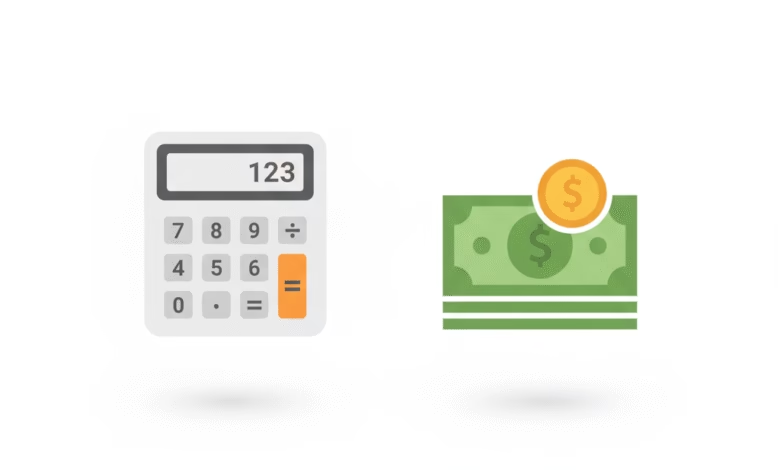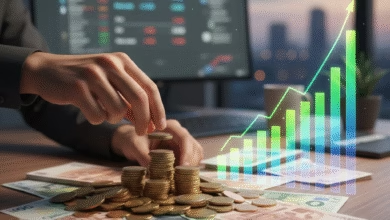How much should you save before you start investing?
Find out how much to save before entering the world of investing

It’s one of the most common questions in all of personal finance: “How much money do I need to save before I can start investing?”
On one side, you hear the constant buzz of investing. News anchors talk about the stock market, friends whisper about their crypto gains, and social media is filled with stories of people building wealth. The “Fear of Missing Out” (FOMO) is real, and it makes you feel like you’re falling behind every day you’re not in the market.
On the other side, there’s the reality of your bank account. You have student loans, a credit card balance, and a nagging feeling that you’re one unexpected car repair away from a financial crisis.
This creates a paralyzing “chicken-and-egg” problem. You need money to invest, but you’re struggling to save. Should you just jump in with $100 and hope for the best?
Stop. Breathe. There is a clear, proven answer to this question.
Successful investing isn’t about when you start; it’s about building a foundation that allows you to stay invested for the long haul. Jumping into the stock market without this foundation is like building a house on quicksand.
This article is your step-by-step blueprint. We will walk you through the exact financial order of operations to know, without a doubt, when you are truly ready to start investing.
What’s the Real Difference Between Saving and Investing?

Before we build the plan, we must be crystal clear on our terms. “Saving” and “investing” are not the same thing. They are two different tools for two very different jobs.
- Saving is for the short term. Its primary goal is safety and liquidity (being able to get your money quickly). You save for a vacation, a down payment, or—most importantly—emergencies. The goal is capital preservation (not losing your money).
- Risk: Extremely low.
- Where it goes: A High-Yield Savings Account (HYSA), money market account, or a Certificate of Deposit (CD).
- Return: Very low, often just enough to (maybe) keep pace with inflation.
- Investing is for the long term (think 5+ years, ideally decades). Its primary goal is growth. You invest for retirement, your kids’ college, or to build generational wealth. The goal is capital growth, which requires taking on risk.
- Risk: Variable to high. The value will go up and down.
- Where it goes: The stock market (401(k)s, IRAs, brokerage accounts), real estate, etc.
- Return: Potentially high, with the goal of significantly beating inflation over time.
You need a solid foundation of savings before you can build the skyscraper of your investments. Here are the non-negotiable steps to building that foundation.
Priority #1: Why Paying Off High-Interest Debt Is a Guaranteed Investment
Before you invest a single dollar in the stock market, you must look at your debt. But not all debt is created equal. We’re talking about high-interest “bad” debt.
This includes:
- Credit card debt (average APR of 18-28%+)
- Personal loans (often 10-36%)
- Payday loans (often 300-400%+)
Why is this Priority #1? Because of the simple, brutal math.
Think of it this way: Paying off a credit card with a 22% APR is the same as earning a 22% guaranteed, tax-free return on your money.
No one—not Warren Buffett, not the best hedge fund manager in the world—can guarantee you a 22% return in the stock market. The historical average of the S&P 500 is around 10% before inflation and taxes.
If you have $1,000 and you’re deciding whether to invest it or pay off your 22% credit card:
- If you invest: You might earn 10% ($100) if it’s a good year. But you still owe 22% ($220) on your debt. You’ve just lost $120.
- If you pay the debt: You have guaranteed yourself a $220 “return” by avoiding that interest payment.
Trying to invest while carrying high-interest debt is like trying to run up an escalator that’s moving down faster. You’re putting in all the effort just to go backward.
What About ‘Good’ Debt vs. ‘Bad’ Debt?
This is a critical distinction. You do not necessarily need to pay off all your debt before investing. You need to pay off the toxic debt.
- “Bad Debt” (High-Interest): This is the debt we just discussed. It has a high-interest rate and was typically used to buy depreciating assets or for consumption (e.g., credit cards, personal loans). This must go.
- “Good Debt” (Low-Interest): This is debt with a low, fixed-interest rate, often used to buy an appreciating asset. The most common examples are:
- A mortgage (with a 3-7% fixed rate)
- Federal student loans (with 4-8% rates)
You can (and should) invest while paying off this “good” debt. If your mortgage is at 4% and the stock market historically returns 10%, you are statistically better off investing the “extra” money rather than paying off your mortgage early.
The rule is simple: If your debt’s interest rate is higher than the conservative expected return from investing (e.g., 8-10%), you should pay off the debt first.
Priority #2: How to Calculate Your Emergency Fund (And Why It’s Non-Negotiable)

Once your high-interest debt is gone (or you never had it—congrats!), you’ve reached the real answer to our title question.
The amount you need to save before you really start investing is 3 to 6 months of essential living expenses.
This is your Emergency Fund.
This is not a “rainy day” fund for a new TV. This is your “life falls apart” fund. It’s the money that covers you when you lose your job, your car’s transmission dies, or you have a medical emergency.
Why Is This Fund So Critical for Investors?
Your emergency fund is not just savings; it is insurance for your investments.
Let’s play out a scenario:
You skip the emergency fund and put your first $5,000 into an S&P 500 index fund. You’re finally an investor! Six months later, the market hits a rough patch and your $5,000 is temporarily worth $4,200.
Then… your transmission blows. The repair is $2,000.
You have no savings. Your only option is to sell your investments. You are forced to sell your stocks at the worst possible time, locking in an $800 loss, just to cover the repair.
This is how people lose money in the market. They are forced to sell at the bottom because they have no other cash.
Your emergency fund is your fortress. It’s the wall that protects your investments from your life. It gives you the power to stay invested during a downturn, which is the only way to build long-term wealth.
How to Calculate Your “3-6 Month” Number
Be honest. This is not 3-6 months of your salary. It’s 3-6 months of your essential survival expenses.
Open a spreadsheet and add up your monthly costs for:
- Rent/Mortgage
- Utilities (Electric, water, gas)
- Groceries
- Transportation (Gas, car payment)
- Insurance (Health, auto, home)
- Minimum debt payments (student loans, etc.)
- Essential personal needs (phone bill, prescriptions)
What’s not on this list?
- Dining out
- Streaming subscriptions (Netflix, etc.)
- Vacations
- Shopping
- Gym memberships
Multiply that “essential” monthly number by 3 or 6.
- Why 3 months? You might aim for 3 months if you have a very stable job (e.g., government, tenured teacher) and a dual-income household.
- Why 6 months? You must aim for 6 months (or more) if you are a freelancer, a gig worker, in a sales/commission-based role, or the sole earner in your household.
What Is a High-Yield Savings Account (HYSA) and Why Is It Essential?

So you’ve committed to saving your $15,000 emergency fund. Where does that money go?
It absolutely does NOT get invested. The goal is safety and liquidity, not growth.
It should NOT sit in your regular checking account. It’s too easy to spend, and it’s earning you 0.01% (nothing).
Your emergency fund belongs in a High-Yield Savings Account (HYSA).
- What it is: An HYSA is a simple savings account, usually offered by online banks.
- Why it’s better: Because they don’t have physical branches, their overhead is low, so they pass the savings to you in the form of much higher interest rates. (Often 4-5%+, while your brick-and-mortar bank is 0.1%).
- Is it safe? Yes. As long as it’s FDIC-insured, your money is protected up to $250,000, just like at a regular bank.
This is the perfect tool for the job. Your money is safe, it’s liquid (you can get it in 1-2 days), and it’s earning some interest to help fight inflation while it waits.
The ‘401(k) Match’ Exception: The Only Time to Invest Before Saving
There is one, and only one, exception to this entire plan: The 401(k) Company Match.
If your employer offers a 401(k) match (e.g., “we will match 100% of your contributions up to 5% of your salary”), this is free money. It’s a 100% guaranteed return on your investment.
This is the only return in finance that beats paying off high-interest debt.
So, the “Financial Order of Operations” gets a slight adjustment. Here is your official, step-by-step priority list:
- Save a $1,000 “Starter” Emergency Fund: Do this first. This small buffer gives you breathing room and stops you from going into more debt while you work the plan. Put it in an HYSA.
- Contribute to Your 401(k) Just Enough to Get the Full Match: If your company matches 5%, you contribute 5%. Not a penny more, not a penny less. This is your first “investment.”
- Aggressively Pay Off ALL High-Interest Debt: Now, take every extra dollar and destroy your credit card debt, personal loans, etc.
- Finish Your Full 3-6 Month Emergency Fund: After the debt is gone, redirect that “debt avalanche” money to your HYSA until you hit your 3-6 month goal.
Once you have completed these four steps, you are bulletproof. You are now ready to really invest.
Your ‘Ready to Invest’ Checklist: Do You Get the Green Light?
How do you know you’ve “made it”? You are 100% ready to move from a “saver” to an “investor” when you can check all of these boxes:
- [ ] I have $0 in high-interest credit card or personal loan debt.
- [ ] I am contributing enough to my 401(k) to get my full company match.
- [ ] I have a fully-funded emergency fund of 3-6 months’ worth of essential expenses.
- [ ] That emergency fund is sitting safely in a High-Yield Savings Account (HYSA).
- [ ] I have a stable monthly budget where my income is greater than my expenses, leaving me with a “surplus” to invest.
If you can check every box, congratulations. You’ve earned the right to start building serious, long-term wealth.
I’m Finally Ready: How Do I Start Investing (Even with Just $100)?
Once you’ve “passed the test,” the next step is to increase your investing. This is the fun part.
Your first “match” dollars were Priority #1. Now, you use your budget surplus to fund other accounts. Your new priority list looks like this:
- Max Out a Roth IRA: An IRA (Individual Retirement Arrangement) is an account you open yourself. A Roth IRA is the best place for most beginners. You fund it with after-tax money, and it grows 100% tax-free forever. This is incredibly powerful.
- Increase Your 401(k) Contributions: After you’ve maxed your IRA, go back to your 401(k) and increase your contribution percentage. Aim to max it out ($23,000 in 2024).
- Open a Taxable Brokerage Account: If you are maxing out both your 401(k) and your IRA (a.k.a. you’re a “rockstar”), you can now open a regular brokerage account to invest for non-retirement goals.
You don’t need to be a stock-picking genius. The simplest, most effective way to start is to open a Roth IRA at a low-cost brokerage (like Vanguard, Fidelity, or Schwab) and set up an automatic monthly transfer to buy a single low-cost index fund or ETF (like one that tracks the S&P 500).
This “set it and forget it” strategy (called dollar-cost averaging) is how real, sustainable wealth is built.
A Final Word on ‘FOMO’ (The Fear of Missing Out)

It can be painful to spend two years paying off debt and building an emergency fund while your friends are bragging about their stock market wins. It will feel like you are falling behind.
You must understand: You are not falling behind. You are building the launching pad.
Your friends who are investing with $20,000 in credit card debt are one small emergency away from financial ruin. You are building a financial fortress.
Investing is a marathon, not a sprint. It’s a “crock-pot,” not a “microwave.” The “boring” work you do to pay off debt and build a savings buffer is what guarantees you’ll be able to stay in the marathon long enough to win.
Don’t skip the most important steps. Build your foundation, and you will build a financial future that is unshakable.





